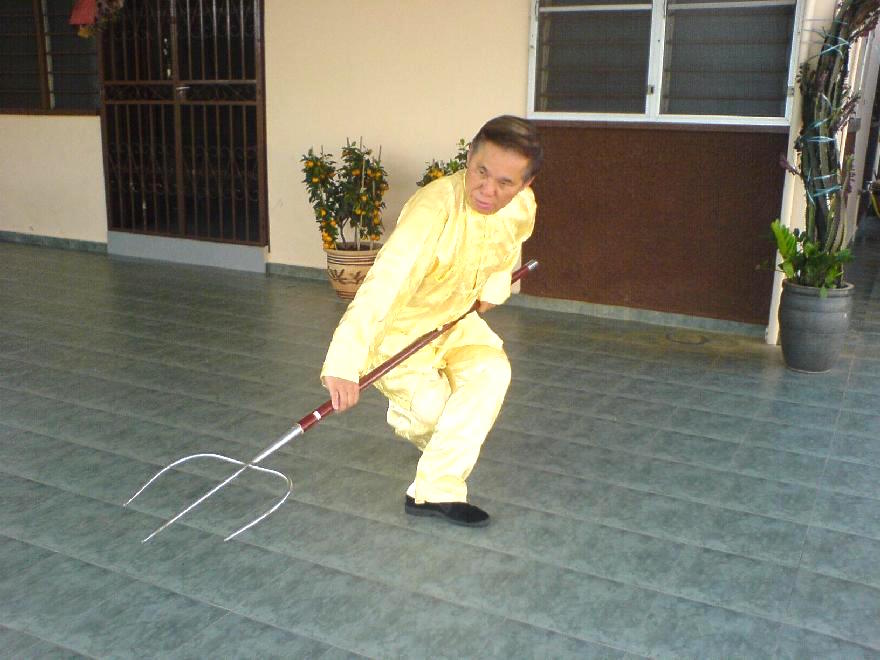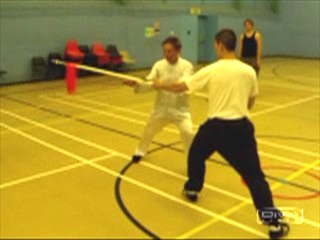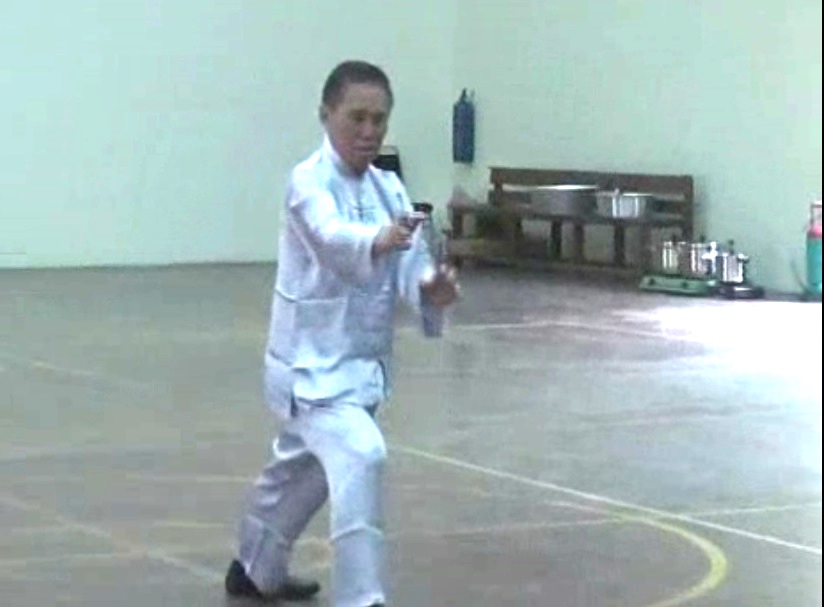SELECTION OF QUESTIONS AND ANSWERS
OCTOBER 2010 PART 3

Grandmaster Wong performing the pattern "Warrior Plays with Tiger" with a Big Trident
Question 1
Sigung, Sifu asked me to direct my questions to you. Yesterday was the first time working out counters to different weapons, and it was extremely difficult. It was amazing how much more shen is required when using weapons.
— Adam, USA
Answer
This is natural. When one does unarmed sparring, he may be punched or kicked. But in weapon sparring, a mistake may result in death or serious injury. Therefore, more shen or presence of mind is required for the weapon holder not to hurt his sparring partner, and for the unarmed defender not to be killed or seriously injured by the weapon.
If the training is done haphazardly, this demand on mental presence may be very stressful. But with systematic training, it enhances our presece of mind. If you can be trained to be relaxed yet fully focused in such a demanding situation, handling less demanding situations in daily life become so much easier.
Question 2
Using the jian against the spear, I felt like I no longer knew kung fu.
Answer
I remember a very illuminating comment by your sifu (Sifu Anthony Korahais) during a weapon course at the UK Summer Camp a few years ago. He said that when he first had to use the short Butterfly Knives against a long weapon like the spear, he did not know what to do.
But after an hour or so of systeamtic training, he really felt pitiful for the opponent holding a long weapon as the opponent would have no chance against the counters of the Butterfly Knives.
Of course this does not mean that Butterfly Knives can always overcome spears; it depends on the relative skills of the two combatants. But it illustrates what a change systematic training does. It transforms a sense of helplessness to a sence of confidence. This is the same with a jian, or a sword, agains the spear. You can find many helpful video clips on my website on how to handle a spear with a sword.

How would you use short Butterfly Knives to counter a long spear attack?
Question 3
As we tried to work out counters, we kept getting into sophisticated situations where I felt that were beyond my current skill level with the weapon. Sifu suggested toward the end of the class that we do more San Da type training working on basic moves and basic counters. This made a lot of sense because it felt like I was trying to jump straight to empty hand sequences 5-16 without building the foundations in sequences 1-4.
Answer
Yes, the basics are very important. First, you need to perform the weapon in solo quite well. Then you practice its individual applications against various attacks. Next you link the attacks into short, meaningful sequences, and work out the counters against them. The sparring here is pre-arranged.
When you are familiar with pre-arranged sparring, you gradually and systematically release control so that eventually the sparring is free. The procedure is the same for both armed and unarmed sparring. You will then be quite confident facing an armed opponent, irrespective of whether you yourself are armed or unarmed.
Question 4
My idea was originally that standard sequences for each weapon combination would be necessary to develop the skills to deal with the different situations. But, after thinking about it for awhile, I wondered if the ideal situation wouldn't be to have interchangeable sequences that can be done with the different weapons, so there isn't so much material to work through.
Similar to using a "Single Tiger" to defend all middle attacks at the beginning, each weapon would have a standard defense to high, middle, low, side, up, and down attacks which would be used regardless of the opponent's weapon. Does this concept hold true when using weapons, or is the difference in the characteristics of the weapons so great that the standard response would have to change according to the opponent's weapon?
For example, with the jian, is dealing with the pierce of the spear similar enough to the thrust of a dao or a straight attack of the butterfly knives that one could have a basic defense to that category of attack that would work regardless of the other weapon?
Answer
No, your concept that a standard defence of one weapon is applicable to all weapons is mistaken. This is because, as you have rightly said, the strength and weakness of different weapons are vastly different. In other words, the standard defence of a sabre against a spear thrust is different from that of a sword against a spear thrust because the strength and weakness of a sabre and of a sword are vastly different.
A sabre is heavy and can be used to deflect a spear thurst before moving it around your body or head to chop at the opponent. This technique is not applicable with a sword because it is light, and its double edges may cut your body or head. But because it is light, you can swiftly move to a side and slice, not chop as in the case of the sabre, the spearsman's hand. This technique, which is suitable for a sword, is not suitable for a sabre because it is too heavy.
As a staff is different from a sword or a sabre, being held in two hands and has no cutting edge, its defence against a spear thrust will be different. You may, for example, flick away the spear thrust, and move in with a hit on the opponent's head.

Shaolin Wahnam chi kung students are recommended to practice for only about 15 minutes a session
Question 5
Also, I know that many of the weapons have specific techniques to use against specific weapons.
Answer
It is not true that many or even any weapons have specific techniques against specific weapons. In other words, it is not ture that if an oppoent uses a particular weapon, like a trident, for example, I would use a particular weapon, like a soft whip, against him, and if he changes to another weapon, I would also change to another weapon that is specifically useful against his weapon.
It is also not true that if an opponent uses a particular technique with his weapon to attack, you have to use a specific technique against his attack. If you are competnent in your weapon, it can be used against any weapons, and you can have many effective counters against any one particular attack.
This reminds me that many years ago a world renounced Western master of Japanese martial arts said that the bo, or the Japanese staff, was specially invented to be used against the katana, or the Samurai sword. The bo, he explained and actually showed by placing it along a katana, was a few inches longer and therefore would defeat the katana.
Even when I was only a kungfu student then, his explanation did not make sense to me. If what he said were true, Samurais would not use their swords; they would be defeated by the longer bo. It is the skills of the warriors, and not the type or length of their weapons, that is crucial in deciding the victor.
Question 6
Is there any way to determine which patterns are more all-purpose and which are more specialized to save time figuring out which moves will work in which situations? As I'm always amazed by the weapon applications you demonstrate in the videos on your website, I really look forward to hearing your thoughts on this.
Answer
This is an academic question, which means the answer may satisfy intellectual curiosity but has no practical value. This does not mean the question is not useful. One good use is to illustrate that if we wish to be combat efficient, we should spend time practicing rather than intellectualizing.
Yes, there are a few ways. One way is as follows. Select a weapon and use it to fight with armed opponents. If you survive the fights, record the patterns you and your opponents used. Analyse them to find out whch patterns are used very frequently and which patterns are used infrequently but with special effects. You can then find out patterns that are more all-purposeful, and those that are specialized.
A better and safer way is as follows. Instead of fighting real opponents, you can fight imaginary ones. Then do an analysis like above to find out the all-purposeful and specialized patterns.
A thrid way is as follows. Instead of you actually do the fighting, real or imaginary, you let others do it. It needs not be new fighting, it can be fighting already taken place, which you can read about or observe from writtern records or videos. Work out the all-purposeful and specialized patterns from an analysis.
But these ways are not practical or effective. They were not the ones I used to become proficient in my weapon training. Then what method did I use to enable me to be amazing in my weapon applications. I am going to share with you the secret.
It was quite simple. I practiced the solo forms of the weapons well. Then I practiced their combat applications. Most of the time I had to practice with imaginary opponents because unlike you and our Shaolin Wahnam students now, I did not have many classmates capable or willing to practice weapon application with me. But when I applied what I trained with imaginary opponents on real persons in sparring (unluckily or luckily, depending on one's perspective, I did not have the chnace to use kungfu weapons in real fights, though in some fights my opponents used improvished weapons) I found it very effective.
Actually what I practiced also involved all-purposeful as well as specialized patterns. Where did I get them as I did not do any prior analysis? I was smart. Instead of doing the analysis myself, I let other people do the analysis, and I benefit from their results. And these other people were generations of fighters, including many masters, in real fightings, often involving life-death consequences. Their findings are crystalized in the weapon sets we practice.

Internal force in kungfu is normally more powerful than that in "chi kung". Yet kungfu students are recommended to practice for an hour whereas chi kung students for only 15 minutes. Would this be over-training?
Question 7
Sifu, a few years ago before I learned chi kung and Shaolin Kungfu from you, my problem was not having enough energy. But after learning chi kung and Shaolin Kungfu from you, my problem now is reverse. I have too much energy. I have to stop my daily practice for a day or two, which I don't like because I enjoy my daily practice. Or I have to go for long walks for hours to use up my excess energy. Can you please give me some advice?
— Ben, UK
Answer
I am very glad of your results. Your kungfu attainment has improved remarkably. I am also glad that you have overcome your earlier problem of not having enough energy.
You can overcome your present "problem" of having too much energy by slowing down your practice or going for long walks, but these are not cost-effective methods. There are better methods for you which I shall explain presently.
I place your "problem" within inverted commas because to you it is actually a privilege in disguise. You can turn this "problem" into a bonus, and use the extra energy to do those interesting things you wanted to in the past but lacked the drive to do so.
But it is a real problem to many other people who over-train. Over-training is a serious problem which can bring serious adverse effects.
But why is it a real problem to other people but a privilege in disguise for you and other Shaolin Wahnam members who practice Shaolin Kungfu or Taijiquan? It is because you and our Shaolin Wahnam members can turn the "problem" into a bonus but the other people can't even if they use the same remedial methods I am going to explain. Why can't the others do so if they use the same methods? It is because they don't have the skills.
An analogy will make this clearer. Suppose you are a skillful cook, but you have over-bought the ingredients. So now you have a "problem" of too much ingredients for your dish. But you can easily change the "problem" into a bonus. You just cook another dish using another recipe that I shall give you. But other people without cooking skills will not be able to cook another dish even when given another recipe.
Here is the recipe that converts your too-much energy into useful energy for extra work and play. After you have developed a lot of energy from your internal force training, when you feel compressed because the newly acquired energy is locked up in your body, have a gentle chi flow and while in chi flow perform one or more kungfu sets, some combat sequences, sparring with a real or an imaginary partner, or any physical or mental activities that you like.
If you are no longer in chi flow when performing these activities, it doesn't matter, but you must perform the activities in a relaxed manner and in a chi kung state of mind. After the activities not only you are not tired, but actually you will have more energy than before you started.
Other people will not be able to do this even if they know the method because they do not have the skills to go into chi flow, or perform the activities in a relaxed manner and a chi kung state of mind.
To let out their pent-up energy, they have to use (in our opinions) inferior methods, like punching a sand-bag, or punching their sparring partners, and working out aggressively in a gym. They would tense their muscles and stress their mind. At the end of the exercise they would have used up much of their energy and be tired and panting for breaths. But they might say they have a good work-out.
Question 8
You advise chi kung students to practice for only about 15 minutes per session. You never fail to warn them not to over-practice. But for Shaolin and Taijiquan students you advise them to practice for half an hour or even one hour per session. I also have heard you say on a few occasions that the exercises in Shaolin and Taijiquan classes are more powerful than the exercises in chi kung classes. Then, wouldn't practicing for an hour or even just half an hour of Shaolin or Taijiquan over-training?
Answer
No, it isn't over-training even when you practice Shaolin or Taijiquan exercises, which are generally more powerful, for an hour, but it can be over-training if you practice chi kung exercises for more than 15 minutes. The reason is that the nature of the training is different.
Relatively speaking, in chi kung training you build, whereas in kungfu (Shaolin and Taijiquan) training you flow. Of course you also flow in chi kung, like in Self-Manifested Chi Movement, and you also build in kungfu, like stance training. But generally in chi kung after chi flow you stand still to build, and in kungfu after stance training you proceed to dynamic movements like kungfu sets, sequences and sparring.
Suppose you perform "Pushing Mountain" for 15 minutes, and you build up 600 units of energy. This is fine if your endurance point is 1000 units. If you practice for half an hour, you would have built up 1200 units, which would be over-training as you are 200 units in excess of your endurance point.
On the other hand, in an hour of kungfu (Shaolin or Taijiquan) training you practice Golden Bridge or Three-Circle Stance, a Shaolin or Taijiquan set, some combat sequences, and some vigorous sparring with a real or an imaginary partner, and you develop 1500 units of energy.
By themselves 1500 units of energy are more than 1200 units. If you have built up 1200 units in half an hour of training, you would have over-trained by 200 units. Wouldn't it be worse if you have developed 1500 units of energy in one hour of training? Yes, if the 1500 units of energy is static, but no, if it is flowing.
As an analogy, if you place a 1.2-ton lorry on a person lying on the ground, you would hurt him. But if you place a sloping plank on him and drive a 1.5-ton lorry over, he may not be hurt. In fact this is a trick sometimes demonstrated by stuntmen.
This is also the same principle that I advise you to utilize to overcome your excessive static energy problem. By making your energy flow, you turn your problem into a bonus.
Will 1500 units of flowing energy be less powerful than 1200 units, or even 1500 units, of static energy? No, in fact it is more powerful. Energy, like cash, is useful and powerful when flowing. It can be harmful if energy remains static for too long.
LINKS
Selected Reading
- Does practicing different kungfu styles or many kungfu sets contribute to or distract from kungfu progress?
- Who says there is no ground-fighting in Shaolin Kungfu?
- Plucking Fruit and Catching Leg
- Monk or President
- Simple in Language, Profound in Meaning
